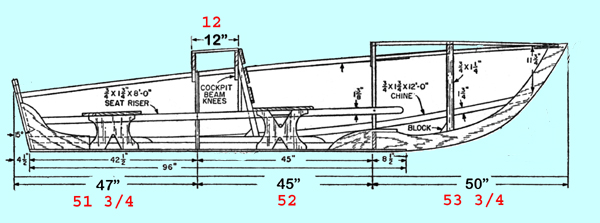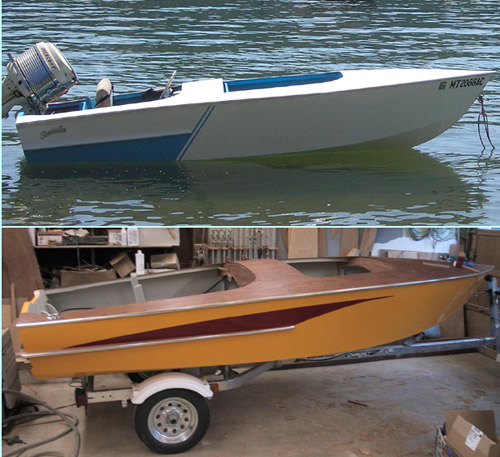Analogous dimensions in red taken from the Waali's 1959 Sande Ace.

We know that the Sandes first made the 12-foot Ace from the William D. Jackson plans but quickly started building 13-foot versions, a change most would recommend to anyone building an Ace today. The Sandes added the extra foot throughout the length of the boat with the middle section getting more length proportionately. That gave a longer forward cockpit in their popular dual cockpit version.

The Jackson plans called for three transom knees but the Sandes used only one, a recognized weakness in their Ace. Recent rebuilds and new constructions have gone back to the three knees.
The Sandes also:
- used stronger 3/8" plywood for the bottom near the bow instead of 1/4" specified in Jackson's plans,
- left out the foredeck beam stanchion shown in the above drawing,
- modified bench center supports,
- deleted the external bottom longitudinal strips and used an aluminum racing fin instead for high speed stability,
- used bottom wedges (1' long, 3 1/2" wide and 3/4" deep at thicker end),
- used somewhat lower transom heights with shims to "fine tune" the motor up to its proper height.
- added an aluminum rub rail,
- left off the points from the two deck frames (~dashboards),
- built an open single cockpit model with steering up front perhaps aiming at folks who wanted the Sande Ace for fishing.
More recently, a beautiful new 13-footer was built by Tom at the Grapeview Point Boat Works by simply extending the lines an extra foot at the rear of the 12-foot plans. This resulted in the rear bench being about a foot more forward than with the Sande Ace and probably less porpoising.
Note: The rear seat back of the white Waali Ace is the blue line. A boat cushion is propped up several inches in front of the seat back.
